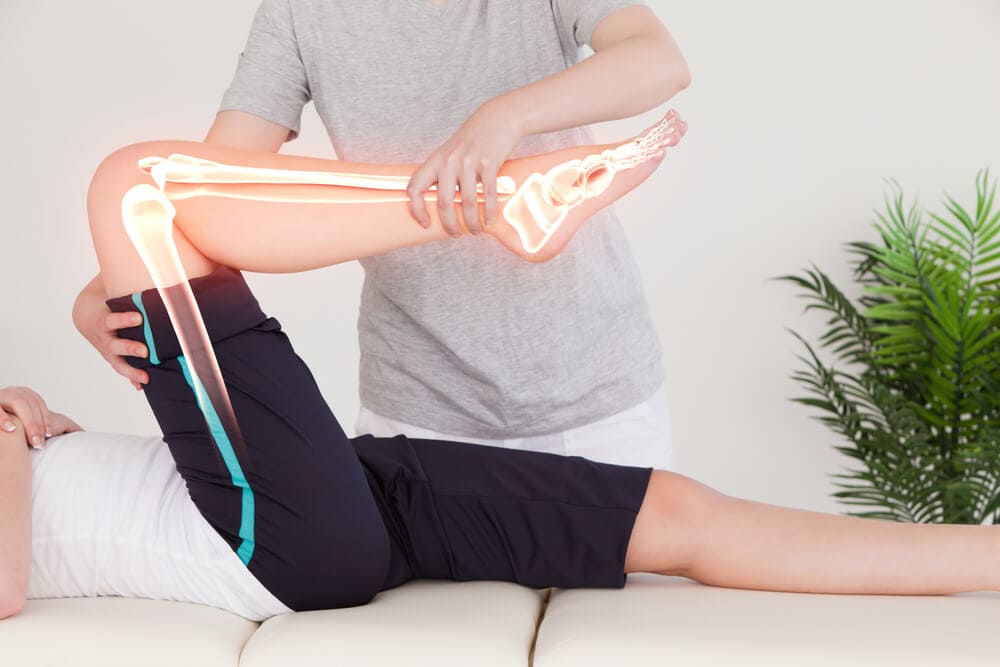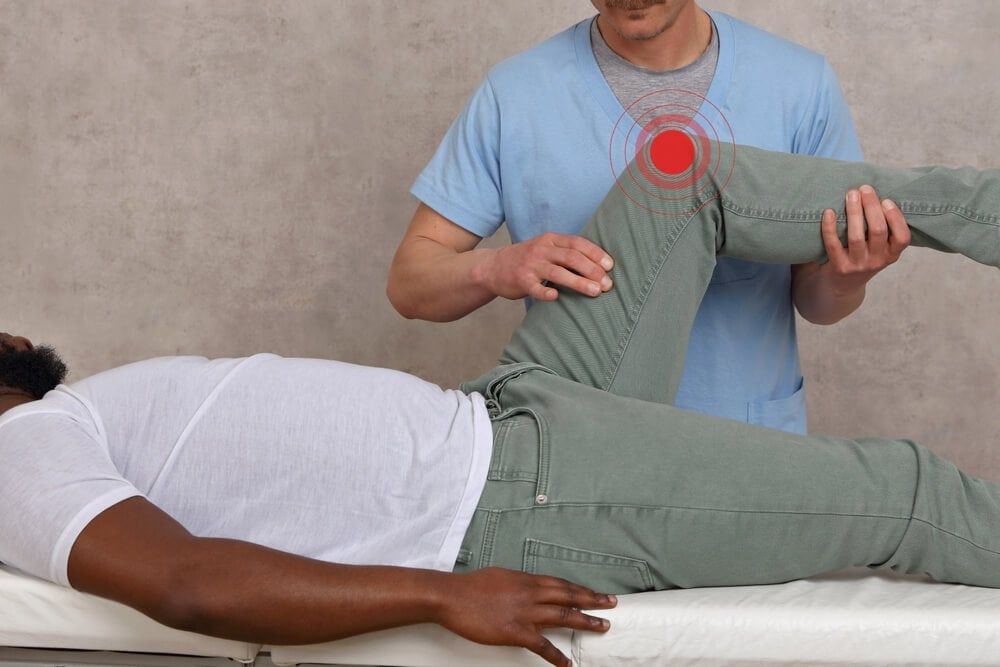Knee pain can happen to anyone of any age. In North America, it is one of the most common musculoskeletal complaints. Osteopathic Manual Therapy treatment can help you with pain management and pain relief. It is a beneficial approach to your rehabilitation, addressing many areas of your body and creating many benefits for you.
The knee is a joint where pain can occur in muscles around or behind the joint, in ligaments, tendons, cartilage, menisci or bursa. Knee pain can occur because of swelling in the joint or around the joint. Knee pain can occur when the knee can’t move well and when the knee moves too much.
What Are The Causes of Knee Pain?
Osteopathic Manual Therapy treatment addresses the root cause of your knee pain. An Osteopathic Manual Therapy practitioner is a mechanic, plumber and electrician who will get your knee back into functional working order.

Knee pain can be acute (lasting a short time) – occurring as a result of an injury or overuse. Knee pain can be chronic (lasting a long time) – occurring when an injury doesn’t heal, as a result of weight gain or posture, or as a result of a chronic illness.
Medical Conditions
There can be medical causes for knee pain. A Medical Doctor (allopathic medicine) would diagnose a medical condition such as arthritis, bursitis, Osgood-Schlatter disease, cysts (Baker cysts), cancer or infections. Osteopathic Manual Therapy practitioners in Canada do not diagnose medical conditions. They can treat the knee using manipulation of joints and tissues to help the knee work better and to help the body self-heal.
Injuries and Overuse
When someone is highly active, is an athlete or a performer of some type they may experience knee pain related to injuries or overuse. Runners can have knee pain associated with a tight IT (iliotibial) band – the thick tissue that is found at the side of your leg, from your hip to the outside of the knee.
Knee Pain in Children, Teens, and Athletes
Children and teens who have hobbies or work spending time on their knees may sometimes experience a fracture of the kneecap or swelling of the patellar tendon or patellofemoral syndrome (pain in the front of the knee).

Strains or sprains of the knee can happen when we have a sudden or unnatural twisting, like stumbling over something. When a little more force happens, like falling down or something hitting our knee, then we can have dislocation (kneecap) or torn ligaments, torn cartilage or torn meniscus. This can leave us with pain inside the knee or on the outside of the knee. A tear in the tissue can also cause swelling and inflammation in the knee.
Osteopathic Manual Therapy Treatment for Knee Pain
Osteopathic Manual Therapy treatment can work with the bones, muscles, tendons and ligaments (mechanics) to get the structure back in the right place for our knee. It can also work to make sure circulation is working correctly (plumbing) and the nerves are communicating well and without pressure on them (electrical). Osteopathic Manual Therapy treatment may reduce the time needed for healing, reduce the pain experienced and increase strength and resilience so you cannot have knee pain in the future.
What Are The Symptom of Knee Pain?
The symptoms of knee pain can vary depending on the location in or around the knee, the cause of the problem and the severity of the experience.
Symptoms can include:
- Weakness, instability, shakiness
- Inability to straighten the knee
- Inability to stop the knee from moving
- Popping, crunching, grinding noises
- Redness and heat/warmth to the touch
- Swelling, stiffness
- Inability to bear weight
- Sharp, searing, stabbing pain
- Dull, achy, gnawing pain
When Do I Consult an Osteopathic Manual Therapy Practitioner?
Osteopathic Practitioners use manipulation of the knee and related body joints and tissue, to get the knee moving properly again. In Canada, consult an Osteopathic Manual Therapy Practitioner when:
- You feel your knee is not stable and gives out
- You are unable to flex or extend your knee properly
- You feel pain in or around your knee
- You twisted your knee and now there is soreness that isn’t going away
- Your knee pain is interfering with your regular daily activity or work

These symptoms do not require a medical diagnosis to be addressed and can be immediately attended to by an Osteopathic Manual Therapy Practitioner.
In Canada, see a medical doctor when:
- You have an open gaping wound in or around your knee
- You have a deformity in your leg or knee
- You have pain with a fever, redness, and streaks of red that are travelling
- You can’t bear weight on your leg because you have searing pain
These symptoms require medical attention. Once you are medically diagnosed and initially treated, Osteopathic Manual Therapy treatment can help you recover faster.
Osteopathic Assessment and Treatment for Knee Pain
Examination of the Knee
In an initial osteopathic appointment, your OMT practitioner will do an initial intake with you. During this assessment, you will discuss the current pain you are experiencing, past injuries, your health history, illnesses or surgeries.
Your osteopathic practitioner will examine your whole body, including your knee. They will assess your posture and look at all the muscles and joints around the knee. They will look for tension, tenderness and balance in all tissues and joints. Your osteopathic practitioner will assess if there is any inflammation, swelling or biomechanical imbalance contributing to your pain.
Treatment Options
After your assessment and during treatment your osteopathic practitioner will use many techniques (for example, trigger points), to move your knee and your whole body in relation to your knee. They will address joints, tendons, muscles, ligaments (mechanics); blood vessels and lymph vessels (plumbing) and nerves in the knee and the spine (electrical).

Our Osteopathic Manual Therapy Practitioner will take the time to educate you on your body, body processes and things you can do to help yourself recover faster and relieve your pain. This may include posture exercises, hydration or movement exercises. This will help you manage your symptoms and feel like you are in control of your healing.
Frequently Asked Questions
Can an Osteopath Help With a Torn Meniscus?
If the tear is small an Osteopathic Manual Therapy Practitioner can help your body work better so it can self-heal and repair tissues faster. If the tear is large, it may need medical intervention first. Once the medical intervention is accomplished, Osteopathic Manual Therapy treatment can help the outcome be more successful and can help you achieve a full recovery.
Can Osteopathy help Osteoarthritis in Knees?
In Canada, Osteopathic Manual Therapy (OMT) can help by applying manipulation (movement) to help osteoarthritis in the knees. OMT in Canada is not Osteopathy (medical Osteopathy). It will not provide medication or medical treatments. It will provide a natural, movement technique to help your circulation work better, repair damage, elements function better, help you stand and bear the load on your knee better, and move better.
Osteopathic Manual Therapy treatment will look at your back, pelvis, feet, thigh, ankle and foot to see the relation to your knee pain. Osteopaths in assessing the knee joint will also consider structures like the tibia, fibula and femur (bones of the leg), the patella (kneecap) imbalances or degeneration in cruciate ligaments or collateral ligaments. Understanding the problems you are having, the levels of pain, mobility, and limited activities can provide information for the best advice, exercise and movements to help you with relief and well-being.
What Knee Pain Do Osteopathic Manual Therapy Practitioners Treat?
Osteopathic Manual Therapy practitioners treat non-medical issues of knee pain and knee pain following medical procedures. They treat knee pain in children – like sporting injuries, play injuries, growth spurt pain, falls and bumps. Osteopathic Manual Therapy practitioners can treat knee pain in the Elderly – pain related to lack of movement, falls, strains, sprains or chronic illness. They treat knee pain in pregnant women – helping with understanding how to manage the newly added weight and the change in softness of ligaments in the woman’s body.
Summary Points
Osteopathic Manual Therapy treatment is beneficial for ensuring the knees and the whole body are functioning to the best potential possible, strengthening the body tissue, enhancing the range of motion, and encouraging the body to be able to respond and recover from injuries as quickly as possible. In this way, osteopathic manual therapy may help to prevent future knee pain.
Source: Annex





